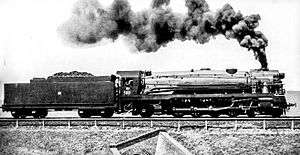New South Wales D58 class locomotive
|
Class D58 Locomotive | |||||||||||||||||||||||||||||||
| |||||||||||||||||||||||||||||||
| |||||||||||||||||||||||||||||||
| |||||||||||||||||||||||||||||||
| |||||||||||||||||||||||||||||||
The D58 class was a class of steam locomotives built by the New South Wales Government Railways in Australia. They were built with the 4-8-2 wheel arrangement.
Design

In 1943 approval was given for the New South Wales Government Railways Workshops to build 25 freight locomotives. The design was a modified version of the 57 class. The main alterations were the use of a rack and pinion valve gear[1] in lieu of the Gresley 2:1 conjugated vale gear for the middle cylinder and the use of smaller cylinders to enable the locomotives to run to on the Main North line to Broadmeadow, a route which had a tighter loading gauge. They also used a Woodard divided drive of twin coupling rods between the second and third driving wheels. A valance was fitted over the valve gear on the front platform.[2]
Construction
Eveleigh Railway Workshops built 11 locomotives and Cardiff Locomotive Workshops two. The first entered service in March 1950. The decision to move to diesel power saw only 13 locomotives completed.[2]
Operations

Whilst the derived rack and pinion valve gear appeared superior in theory, in practice it required more maintenance and lubrication. The smaller diameter cylinders demanded a later cut-off and used more steam, thus making the locomotives uneconomical in the use of coal and water when compared with the 57 class. Despite the design being made to enable use on the Main Northern line from Sydney to Broadmeadow, few journeys were ever made on this route. They mainly were used on the Main Western line to Lithgow and in a limited capacity on the Main South line to Junee.[2][3]
After a very short service life, the entire class had been withdrawn by July 1957 and were all cut up by March 1964. Some parts were recovered and used on 57 class locomotives. There are no surviving examples, however the tender of 5808 lies near Canberra station. Some 58 class tenders saw further use as water tankers around New South Wales. One is at the Dorrigo Steam Railway and Museum.[3][4]

References
- ↑ Slee, David E (January 2000). "D57 and D58 Classes—Design Differences and Power Comparisons". Australian Railway Historical Society Bulletin: 3–19.
- 1 2 3 Grunbach, Alex (1989). A Compendium of New South Wales Steam Locomotives. Sydney: Australian Railway Historical Society, NSW Division. pp. 232–235. ISBN 0 909650 27 6.
- 1 2 Oberg, Leon (1984). Locomotives of Australia 1850's - 1980's. Frenchs Forest: Reed Books. pp. 168–170. ISBN 0 730100 05 7.
- ↑ Wright, H (July 1964). "The Last of the 58-Class 'Mountain' Locomotives". Australian Railway Historical Society Bulletin: 130–132.
